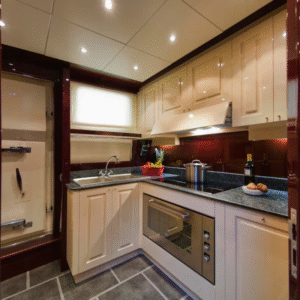Some homes look like they were simply dropped from the sky, blending so naturally into their surroundings that you wonder if the land itself had been waiting for them. That is the essence of the Franz Home project, a log cabin retreat that redefines what it means to build on lakefront property while honoring the spirit of the land.
Designing and constructing a home in such a setting is not a straightforward task. Lakefront properties carry unique challenges, setbacks, low-lying terrain, and delicate water systems that demand vision, patience, and a commitment to balance.
The Franz Home from Holland Log Homes demonstrates how these challenges can be addressed without compromising either the homeowner’s dream or the natural beauty of the site.
Designing for Dreams and Nature
Perhaps the greatest triumph of the Franz Home project was not in overcoming technical obstacles but in weaving the homeowner’s desires into the design without breaking harmony with the environment.
The owner envisioned a true log cabin, a place of warmth, retreat, and family gatherings. This dream could have easily conflicted with the fragile lakefront ecosystem. Instead, design decisions aligned with each other. The cabin is situated to maximize panoramic views without compromising mature tree lines. Natural light was prioritized to reduce reliance on artificial systems, while materials were selected to age gracefully, mirroring the tones of the surrounding woods.
This balance made the cabin appear less like new construction and more like a long-standing resident of the shoreline. It’s a reminder that homes, when thoughtfully designed, can feel as though they belong to the landscape from the very first day.
Building Without Disturbance
One of the most striking aspects of the Franz Home is the minimal evidence of disturbance that remains after construction. Too often, building near lakes leaves scars, cut trees, degraded slopes, or exposed soil. Here, the opposite occurred.
Strategic placement minimized clearing, allowing the forest canopy to remain intact. Natural drainage patterns were preserved, and pathways were carefully laid to integrate with the site’s natural contours. Even the construction process itself was handled with restraint, utilizing methods that minimized the impact of heavy machinery.
The effect is almost magical. Visitors feel as if the cabin has always been there, resting peacefully by the water, with the stream still meandering and the trees still whispering overhead.
Lessons for Future Lakefront Builds
The Franz Home project offers valuable lessons for anyone considering building a log cabin homes on lakefront property:
- Respect Setbacks as Opportunities – Instead of viewing regulations as restrictions, use them as guides to frame views and protect natural assets.
- Work with Topography, Not Against It – Low terrain can be safeguarded without stripping away character; careful elevation preserves both beauty and safety.
- Honor Natural Water Systems – Streams and lakes are not obstacles, but living features to be integrated into the design.
- Prioritize Owner Vision Within Context – Dreams and nature can coexist; it just requires creative design thinking.
- Minimize Construction Footprint – The true measure of success is whether the land feels undisturbed once the home is complete.
Conclusion
Building a log cabin home on lakefront property requires far more than lumber and blueprints. It requires sensitivity, patience, and a philosophy that places nature and homeowner dreams on equal footing. The Franz Home shows how this balance can be achieved, where setbacks become strengths, where streams remain undisturbed, and where the cabin itself feels like it has always belonged.


